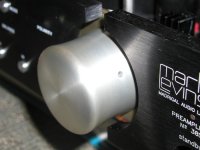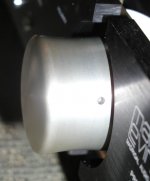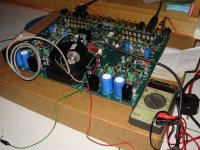As this is true diy, I didn't look for help from machine people. I used 2" aluminum rod. Cut it to length first and drilled center hole (and screw mount) to be able to install 1/4" shaft.
First, I mounted the knob on hand drill and while rotating it, shaped on belt sander (80 grid belt). I made the side bevel, rounded the top face and created shamfering on the rim.
Later, I installed the knob on a drill press and while using maximum speed, proceded with further shaping by using air grinder and different grid, 2" abrasive pads. I started with 36 grid and finished with 240 and scotch brite fine grade pad.
The whole thing took me about 1 1/2 hr and later additional half hour for final polishing and etching.
Well, the accuracy is pretty good and I don't think it would be much easier to do it on lathe. This is pretty complicated shape and by slowly sanding it off, one is sure that desired shape is achieved.😉
First, I mounted the knob on hand drill and while rotating it, shaped on belt sander (80 grid belt). I made the side bevel, rounded the top face and created shamfering on the rim.
Later, I installed the knob on a drill press and while using maximum speed, proceded with further shaping by using air grinder and different grid, 2" abrasive pads. I started with 36 grid and finished with 240 and scotch brite fine grade pad.
The whole thing took me about 1 1/2 hr and later additional half hour for final polishing and etching.
Well, the accuracy is pretty good and I don't think it would be much easier to do it on lathe. This is pretty complicated shape and by slowly sanding it off, one is sure that desired shape is achieved.😉
Attachments
Peter Daniel said:Cut it to length first and drilled center hole (and screw mount) to be able to install 1/4" shaft.
Fabulous.
What tool did you use to cut it off?
karma said:looks good are you going to make it white?
For now it's OK, it's pretty whitish anyway (after etching) and matches the buttons. When I'll have a chance I might give it to a shop for better finishing, but I'm not sure yet, have to see it in daylight.
However, the "feel" is much better with that heavy knob. The aluminum seemed pretty hard, it was T6511. Could it be because of that?
it looks great. when i saw one it looked like it was anodized perl white but it was a softer aluminum that nics easy
so i say yours is better😉
so i say yours is better😉
this guy does it at home hmm
http://www.wcc.net/~jkmccoy/shop/anodiz.htm
🙂
!!and there is a warning!! dangerous chemicals used
http://www.wcc.net/~jkmccoy/shop/anodiz.htm
🙂
!!and there is a warning!! dangerous chemicals used
Its easy to anodize at DIY basis, but there is little point to it. Its very cheap to have things anodized, and the lead time is short.
An example:
12 heatsinks 180*180*80mm anodized, one week lead time. less than 50 euro.
Magura🙂
An example:
12 heatsinks 180*180*80mm anodized, one week lead time. less than 50 euro.
Magura🙂
Hi guys! This is my humble version of the #38 board (not 38s) I bought. It is nowhere compared to the beautiful work by Peter Daniel here(wow!). It is a lot of work to get it working, but hey i didn't have a schematic <sigh> Can u guys point me to a right value or model for the HP encoder? Mine is 500 turns & seems to take forever to adjust volume. In time I would like to add a display and input switching too, maybe remote too 🙂 Hope the picture shows up...
Attachments
kenny_(00)_ said:Hi guys! This is my humble version of the #38 board (not 38s) I bought. It is nowhere compared to the beautiful work by Peter Daniel here(wow!). It is a lot of work to get it working, but hey i didn't have a schematic <sigh> Can u guys point me to a right value or model for the HP encoder? Mine is 500 turns & seems to take forever to adjust volume. In time I would like to add a display and input switching too, maybe remote too 🙂 Hope the picture shows up...
The best person to contact regarding encoder (I think it's either 100 or 200ppm) and display board is a forum member: Algar_emi. He designed, based on original schematic and photos, the fully functionalal display board, as well as remote control board and a small, Stand by board. I think the original HP encoders are still available from ebay, but they have to be modified, so even when they are pretty cheap (about $10, after modification the price is pretty close to the new ones from Newark).
markp said:How much did it end up costing you? Did you save any money?
The regular ML38 board came up to about $200, including shipping from Singapore. ML38S was double that price.
Parts fot display board are about $100 (where $50 is cost of two display modules). Parts for remote are about $15. Encoder may cost you $10 (if sourced from ebay, another $40 when you decide to convert it to the original type).
Health risks in machining aluminum?
Goodness!
Amazing job, Peter. How can one compete...? Sigh. Terrific work.
After reading about how you made your fabulous knob, I have just a quick question to you and any other machinists about working with aluminum: are there any health risks in drilling, milling, or sanding aluminum that we should be aware of?
Many years ago when I was in art school, I wanted to make a small lamp by milling out a block of aluminum. There was a TA there who would absolutely not help me mill the aluminum, stating that she didn't want to have health problems later by exposing herself to aluminum dust and shavings.
I didn't pursue it after that, and to this day I still don't know if she was right or mis-informed about the health risks.
Can anyone set me straight on this? I greatly appreciate it.
Thanks,
KT
Goodness!
Amazing job, Peter. How can one compete...? Sigh. Terrific work.
After reading about how you made your fabulous knob, I have just a quick question to you and any other machinists about working with aluminum: are there any health risks in drilling, milling, or sanding aluminum that we should be aware of?
Many years ago when I was in art school, I wanted to make a small lamp by milling out a block of aluminum. There was a TA there who would absolutely not help me mill the aluminum, stating that she didn't want to have health problems later by exposing herself to aluminum dust and shavings.
I didn't pursue it after that, and to this day I still don't know if she was right or mis-informed about the health risks.
Can anyone set me straight on this? I greatly appreciate it.
Thanks,
KT
Anything can have ill influence and deteriorate your health. Although I didn't noticed any particular damaging effects of working with aluminum, a work like this, where aluminum dust is everywhere, is preferrably done outside. Aluminum is not really that toxic, IME. Whenever I work with copper though, I can't stand enhaling the dust. It makes you sneezing right away.
Hi,
I used to work as a machinist and if we machined lots of Ali I could feel a little bit rough - but this would be days of it in big CNC machines.
If Ali was very bad it would have made big news by now - lots of it gets machined because its soft yet still strong.
Just take the sensible precautions, wear a dust mask (buy a good quality one if you plan doing lots - it'll last longer and provide better protection), work outdoors of possible, in a garage with the door open if possible and lastly indoors with windows wide open.
If you can't do those, minimize exposure, after cutting leave the room and let the dust settle then gently clean it up.
All these apply to all materials - mdf for speakers being a good example, its dust can be very fine and get far into your lungs.
If in doubt about any material at all, do proper research and seek expert advice.
Have fun and just take sensible care.
😉
I used to work as a machinist and if we machined lots of Ali I could feel a little bit rough - but this would be days of it in big CNC machines.
If Ali was very bad it would have made big news by now - lots of it gets machined because its soft yet still strong.
Just take the sensible precautions, wear a dust mask (buy a good quality one if you plan doing lots - it'll last longer and provide better protection), work outdoors of possible, in a garage with the door open if possible and lastly indoors with windows wide open.
If you can't do those, minimize exposure, after cutting leave the room and let the dust settle then gently clean it up.
All these apply to all materials - mdf for speakers being a good example, its dust can be very fine and get far into your lungs.
If in doubt about any material at all, do proper research and seek expert advice.
Have fun and just take sensible care.
😉

- Home
- Amplifiers
- Solid State
- Building Mark Levinson 38 preamp chassis from scratch


